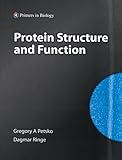Protein structure and function / Gregory A. Petsko, Dagmar Ringe.
Material type: TextSeries: Primers in biologyPublication details: London : New Science Press ; Sunderland, MA : Sinauer Associates ; Oxford : Blackwell Pub., c2004.Edition: 1st edDescription: xxii, 195 p. : col. ill. ; 28 cmISBN:
TextSeries: Primers in biologyPublication details: London : New Science Press ; Sunderland, MA : Sinauer Associates ; Oxford : Blackwell Pub., c2004.Edition: 1st edDescription: xxii, 195 p. : col. ill. ; 28 cmISBN: - 0878936637 (Sinauer Associates)
- 9780878936632
- 0953918149 (New Science Press)
- 1405119225 (Blackwell Pub.)
- 572.633 22
- QP551 .P3974 2004
- 2003 M-267
- QU 55
| Item type | Current library | Call number | Status | Date due | Barcode | |
|---|---|---|---|---|---|---|
 Books
Books
|
Centeral Library Second Floor - Biotechnology | 572.633 P.G.P 2004 (Browse shelf(Opens below)) | Available | 11667-2 | ||
 Books
Books
|
Centeral Library Second Floor - Biotechnology | 572.633 P.G.P 2004 (Browse shelf(Opens below)) | Available | 11667-1 |
Browsing Centeral Library shelves, Shelving location: Second Floor - Biotechnology Close shelf browser (Hides shelf browser)

|

|

|

|

|

|

|
||
| 572.6 T.R.P 2014 Principles of proteomics / | 572.60285 G.M.P 2010 Protein bioinformatics : | 572.633 B.Y.P 2007 Protein folding protocols / | 572.633 P.G.P 2004 Protein structure and function / | 572.633 P.G.P 2004 Protein structure and function / | 572.64 Z.A.P 2009 Protein interaction networks : | 572.64 Z.A.P 2009 Protein interaction networks : |
including index
Includes bibliographical references (p. 181-188) and index.
Published by New Science Press and distributed in the U.S. and Canada by Oxford University Press
This text introduces general principles of protein structure, folding, and function, then goes beyond these basics to tackle the conceptual basis of inferring structure and function from genomic sequence. It is the first book in a series, Primers in Biology, employing a modular design in which chapters are divided into topics, each occupying one two-page spread that includes the relevant text, illustrations (in full color), definitions, and references.
The book has five chapters. The first is an introduction to the principles of protein structure and folding, with emphasis on proteins' biophysical properties. The second describes the principles of the main biochemical functions of proteins, namely binding and catalysis, with a short section on the properties of structural proteins. Chapter 3 covers the regulation of protein function, containing concise descriptions of all the regulatory mechanisms that operate on proteins, from pH to phosphorylation, with several sections on protein switches based on nucleotide hydrolysis. Chapter 4 introduces the principles whereby structure and function are deduced from sequence, with illustrative examples. The final chapter addresses how data on protein structure is gathered, interpreted, and presented.
Written for upper-level undergraduates and beginning graduate students, Protein Structure and Function is also be for working scientists needing an up-to-date introduction to the field.
There are no comments on this title.

